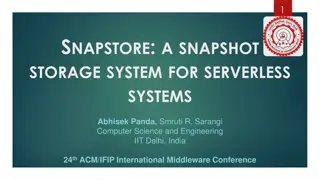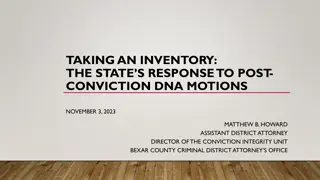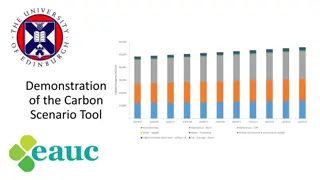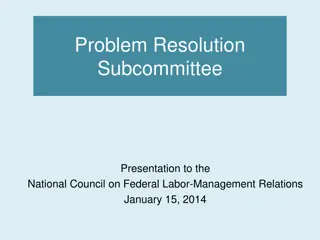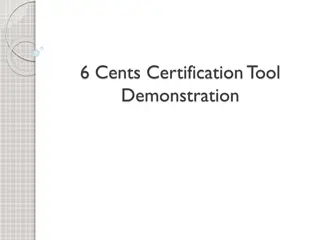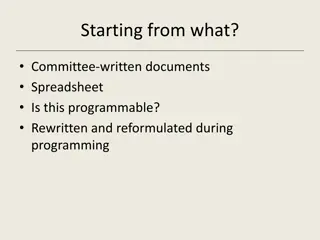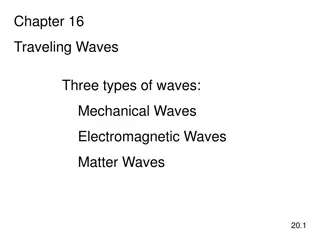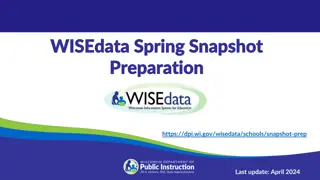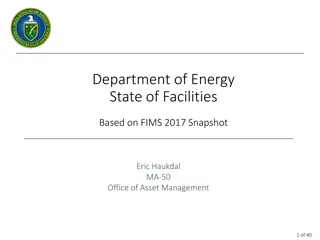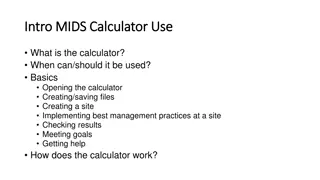Snapshot-Based State Management Tool
Capture and restore machine states effortlessly using the Snapshot-Based State Management Tool. Easily create configurations, take snapshots, and restore to previous states with just a few steps. Organize configurations in a tree structure for efficient management. Modify setpoints before restoration and define delta thresholds for a smoother process.
Download Presentation

Please find below an Image/Link to download the presentation.
The content on the website is provided AS IS for your information and personal use only. It may not be sold, licensed, or shared on other websites without obtaining consent from the author.If you encounter any issues during the download, it is possible that the publisher has removed the file from their server.
You are allowed to download the files provided on this website for personal or commercial use, subject to the condition that they are used lawfully. All files are the property of their respective owners.
The content on the website is provided AS IS for your information and personal use only. It may not be sold, licensed, or shared on other websites without obtaining consent from the author.
E N D
Presentation Transcript
Save Restore Kunal Shroff, Kay Kasemir, Georg Weiss and many other
Motivation and Objectives The short version: Take snapshot(s) of current machine state, and allow users to restore back to this state anytime in the future.
Save Restore Similar, but different purpose tools Autosave Single IOC bumpless rebooting Archiver Archive periodically Save time serially data
Motivation and Objectives Restore you machine back to a golden state in 3 steps Step 1: Create a Save Restore Configuration This is a list of all the PV s which should be Step 2: Take a Snapshot Save all the current values for all the PV s listed in the Save Restore Configuration Step 3: Restore a Snapshot Using one of the previously created Snapshot, Restore the snapshot by setting the values of all the PV s listed in the configuration to the values stored in the snapshot.
Create a Save Restore Configuration New configurations can be created using: The Save and Restore App From the context menu action
Create a Save Restore Configuration Name Description List of PV s (set points) Associated readback PV s (optional) Read only flag
Create a Save Restore Configuration Organize your Save Restore Configuration Save Restore Configurations can be organized in a tree structure Folder is an abstraction to support a fine-grained hierarchy
Restore from the snapshot view Compare to live values Modify individual setpoints before invoking restore Modify all setpoints using a scaling factor Select a subset of PVs subject to restore Define delta threshold for better readability Filter on PV name Limited view on complex types like arrays and tables PV write operation order is arbitrary and asynchronous.
Motivation and Objectives. In addition to creating/taking/restoring snapshot the Save and Restore eco system has a host of other feature to help: Analyze snapshot/s Compare snapshot Aggregate multiple snapshots for easier restore of composite snapshots Organize and Find snapshots Tag snapshots to facilitate search. Search tool: find configurations and snapshots based on meta-data (name, date, contained PV names, tags ) Filtering: search criteria can be saved as a filter and applied in the UI to highlight matching snapshots or configurations Security Authentication and authorization: protects data and restricts access to restore operations Integrate external datasources Archiver integration: snapshots can be compared to archiver data, or created from archiver data.
Manage your Snapshots Tag Golden Tag with some comment Rename Delete Export to CSV (legacy, limited type support)
Compare snapshots A snapshot may be compared to other snapshots (same configuration), or to archived data.
Create composite snapshot Facilitates restore operations Snapshots (or composite snapshots) added through drag-n-drop Combined list of PVs must not contain duplicates Composite snapshot defined by its items, i.e. there is no associated configuration object. Snapshots cannot be deleted if contained in a composite snapshot.
Searching for objects In the search view users may search for objects (snapshots, configurations ) based on meta data like name, tag, date, contained PV names etc. A search query may be saved as a named filter. An active filter in the tree view will highlight matching items
Save and Restore integration with Phoebus Services Pluggable Interface for adding specific operations when Snapshots are created Snapshots are restored SaveAndRestoreEventReceiver { void snapshotSaved( ); void snapshotRestored( ); } e.g. SaveAndRestoreEventLogger Creates a Log Entry in Olog when a snapshot is created/stored or restored
Save Restore Architecture Phoebus Save & Restore Application Display Builder Actions Clients python java HTTP(S)/REST Solutions Storage REST API Data Server Save and Restore R E S T Archiver Appliance Data Retrieval Services core-pv core-pv Credential Manager AA archive appliance CA / PVAccess ca/pva IOC s
Save and Restore Data Types All EPICS data types supported, but UI representation has limitations.
Save and Restore Release 5.0 Upcoming release version 5.0.0 Authentication/Authorization. Integration with OpenLDAP or Active Directory. Protects data and restricts access to operations. Server side IOC interaction. Allows arbitrary clients (scripts) to perform operations, e.g. restore. Phoebus client connects only to show live values. Archiver integration: compare snapshot to archived data, or create snapshot from archived data. Action Button widget integration: open objects in save&restore UI.
Next Steps Save and Restore with Action Button widget Action Button widget can open objects in the save&restore UI (e.g. snapshots) Additional use cases to be supported: Create a new snapshot for a given configuration Restore a snapshot
Step 3: Restore a Snapshot Save Restore Service Documentation and API https://control-system- studio.readthedocs.io/en/latest/services/save-and- restore/doc/index.html Save Restore Client https://control-system- studio.readthedocs.io/en/latest/app/save-and- restore/app/doc/index.html
Thank You for Your Attention Any Questions? Just Ask!



